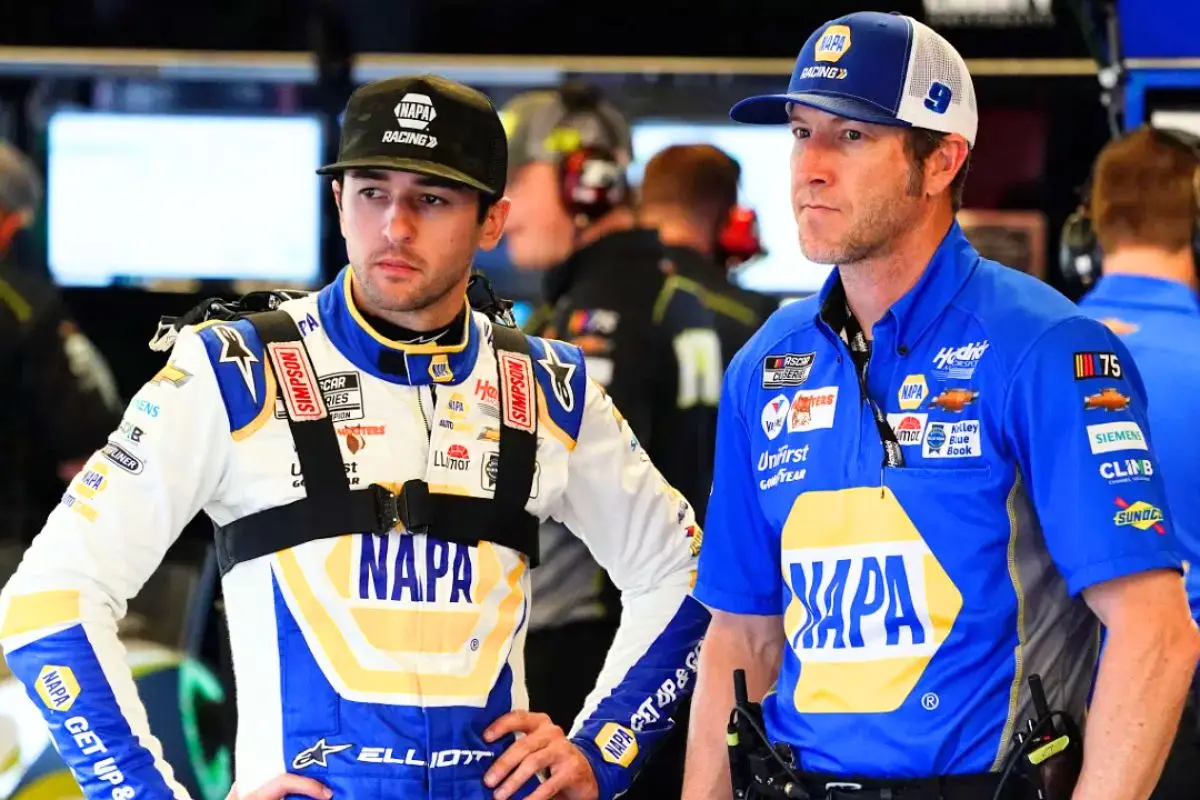Alan Gustafson has faced mounting criticism as the perceived ‘culprit’ behind Chase Elliott‘s struggles in the playoffs. Fans and analysts similarly are questioning his tactical choices, particularly during key races. Despite a history of success marked by their partnership, recent performances at Darlington and beyond have ignited debate about Gustafson’s decision-making. As Elliott navigates playoff demands, the tension between fan frustrations and expert defense highlights ongoing complexities. The discussion around their dynamics continues to unfold.
Key Highlights
- Chase Elliott’s recent struggles in the playoffs have led fans to blame crew chief Alan Gustafson for strategic missteps.
- Critics cite Gustafson’s decision-making during races as a key factor in Elliott’s disappointing performance.
- Elliott’s 2020 championship success contrasts sharply with current challenges, intensifying scrutiny on Gustafson’s strategies.
- Despite criticism, analyst Tommy Baldwin defends Gustafson, noting the complexities of the Next-Gen car affecting race outcomes.
- Elliott’s calculated yet inconsistent performance at Darlington exemplifies the ongoing tension between fan frustration and measured analysis of Gustafson’s leadership.
Chase Elliott and Gustafson’s Trusted Partnership
Although recent performance challenges have led to scrutiny, the partnership between Chase Elliott and crew chief Alan Gustafson remains a cornerstone of Elliott’s racing career. This enduring collaboration, initiated during Elliott’s rookie Cup Series season in 2016, is characterized by mutual trust and the freedom to innovate.
Elliott has publicly acknowledged Gustafson’s role in cultivating an environment where he can express himself fully, a vital aspect of their success, including the 2020 NASCAR Cup Series championship.
However, as Elliott navigates the demands of the playoffs, criticism from fans has intensified, with many attributing tactical missteps to Gustafson. This scrutiny risks overshadowing the profound rapport that has defined their relationship and contributed greatly to Elliott’s growth as a driver.

A Calculated Run at Darlington
How effectively did Chase Elliott execute his plan at Darlington? Elliott’s approach was characterized by calculated aggression and adaptability.
Early in the race, he joined Brad Keselowski for synchronized pit stops, a decision reflecting tactical foresight. Despite a close encounter with Carson Hocevar that could have derailed his momentum, Elliott exhibited resilience, maintaining focus on the race’s objectives.
Chase Elliott’s tactical foresight and resilience shone through as he navigated early challenges with precision and focus.
Midway through, as leaders pitted, Elliott took advantage of the opportunity, briefly seizing the lead—an indication of his keen situational awareness.
However, his decision to pit on lap 195 resulted in relinquishing that position. Nevertheless, he sustained a competitive pace, positioning himself for upcoming challenges as the race’s dynamics continually evolved, highlighting his tactical insight.
Would not have thought Chase Elliott and Christopher Bell would be lapped cars in the final laps of the playoff opener. Woof.
— Jeff Gluck (@jeff_gluck) September 1, 2025
Strategy Questions and Playoff Pressure
What factors influenced Chase Elliott’s tactical choices as playoff stress mounted? In the high-pressure environment of the postseason, Elliott’s strategy shifted towards consistency rather than aggressive risk-taking.
Having experienced a challenging 2023, he accepted a long-game approach, focusing on calculated results to improve his playoff prospects. The decision to secure a free pass under caution exemplified this tactical recalibration, aiming to preserve his position within the top ten.
“Chase won’t make the last round.”
“Gustafson has cost 9 team like 30 total positions tonight lol.” – NASCAR fans’ Reaction
Despite criticism directed at his crew chief, Alan Gustafson, Elliott’s steady performance—reflected in an impressive average finish of 11.96—positions him as a strong contender.
In contrast to his teammates’ speed, Elliott’s methodical strategy has established a resilient foundation, essential for maneuvering the complexities of the playoffs.

A Steady Result Amid Chaos
As the race unfolded at Darlington, Chase Elliott navigated a tumultuous environment with a level of composure that belied the chaos surrounding him. Despite a challenging start, he exhibited resilience and tactical awareness, culminating in a P17 finish that preserved his playoff position.
Key aspects of Elliott’s performance included:
- Qualifying 21st: A suboptimal starting position that set the stage for an uphill battle.
- Progression in Stages: Moving from P21 to P19 in Stage 1, then back to P21 by Stage 2’s end, highlighted his adaptability.
- Tactical Consistency: Amidst fluctuating strategies, his ability to maintain pace was notable.
- Playoff Advancement: Ultimately, the solid finish did not jeopardize his advancement to the Round of 12, exemplifying his tenacity.
Fans and Analysts Clash Over Gustafson
Chase Elliott’s recent performances have sparked intense debate among fans and analysts, particularly regarding crew chief Alan Gustafson‘s role in the team’s struggles.
“Chase is there because his crew chief is terrible and his pit crew is awful.” – NASCAR fan Reaction
Frustration has boiled over on social media, with fans attributing Elliott’s disappointing results—such as a 26th-place finish at Watkins Glen—to Gustafson’s strategy and decision-making. Critics argue that his leadership has cost the team valuable positions, while others express a desire for media narratives to shift away from portraying Gustafson favorably.
“Hopefully this is the breaking point where NASCAR media can stop gaslighting Chase fans that watch every week that Alan Gustafson is good.” – NASCAR fan Reaction
In contrast, veteran analyst Tommy Baldwin defends Gustafson, citing the complexities of the Next-Gen car and emphasizing his track record of success.
The dichotomy highlights the tension between passionate fan sentiment and the measured perspectives of seasoned analysts in NASCAR.
![]()
News In Brief: Chase Elliott’s Huge Playoff Setback—Is Gustafson the Culprit
In the aftermath of Chase Elliott’s notable playoff setback, Alan Gustafson’s role has come under scrutiny, highlighting the complexities of their partnership. While some fans and analysts blame Gustafson for the missteps, others recognize the inherent risks involved in tactical decision-making under stress. As the playoffs unfold, the duo’s ability to adapt and communicate effectively will be essential. Ultimately, their continued collaboration will determine whether they can overcome this challenge and reclaim their competitive edge.
ALSO READ: Chase Elliott Left Out as Family Picks HMS Rising Star for Cup Glory!
